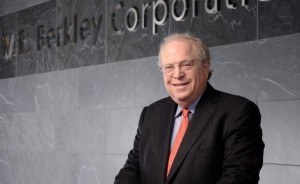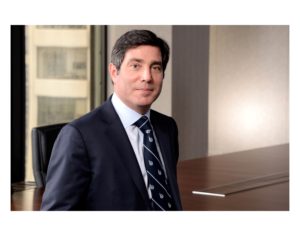

External capital supporting new entrants to the property/casualty insurance and reinsurance markets is a “drop in the bucket” when measured against the magnitude of recent events, an industry leader said on Tuesday.
Speaking at the RBC Capital Markets Global Financial Institutions Conference, William R. Berkley, executive chair of W.R. Berkley Corp. made the observation as he described what he believes will be an “extraordinary year” for the commercial specialty insurer he started more than 50 years ago.
“This storm in Texas, I don’t know if it’s going to be a $25 or $50 billion loss [for the industry]. But that’s probably five- or 10-times the amount of capital that people are talking about coming into the industry,” Berkley said, countering the notion that new entrants will dampen hard market pricing.
“This is a huge business. And all the capital together that’s come in is just not significant to the volume needed as this business starts to tighten up. We’re not particularly concerned with new capital rushing in. It’s very marginal,” he said.
RBC Capital Markets Analyst Mark Dwelle agreed, noting that the capital formation today is not as impactful as levels of past hard markets in 1986-87 and 2001-02. “In dollar terms, it might’ve been similar amounts. But the size of the industry capital base is so much broader that $20 billion of new money or whatever just doesn’t move the needle like it [did] in ’86 or 2001,” Dwelle said.
Moments earlier, Berkley and his son, President and Chief Executive Officer W. Robert Berkley, Jr. offered views that the hard market for all lines except workers compensation would extend into 2022 at least.

“We’re having rate on rate for the first time in a long time. And not just rate on rate, but rate on rate where the rate is exceeding social and economic inflation by a substantial margin.”
William R. Berkley
“We do have lower interest rates. But it’s being more than offset by the kind of underwriting margin that’s going to be available. So we see 2021 and 2022 as extraordinary years. And maybe even a little past there,” he said.
“By and large, we do not see it eroding at this stage,” Robert Berkley agreed, responding when Dwelle asked for details on market momentum. Pointing to three initial hard market drivers: the low investment return environment, rising loss cost trends—specifically social inflation—and “a reinsurance market place that seems to be waking up [and] recognizing they probably have lost a lot of capital over the past several years,” Berkley Jr. contrasted the current market with hard market periods in around 2001 and 1986. In those prior periods, “you saw product lines marching much more in lockstep when you think about how they made their way through a cycle.” But in 2021, different product lines are in different places in the cycle.
In particular, workers compensation in the United States remains “the big outlier,” the younger Berkley said. “Other than workers compensation, as far as the commercial marketplace that we participate in, every product line is getting rate increases that outpace loss cost trend based on our measurements and our metrics,” with public D&O and excess liability seeing the biggest rate jumps.
Even property lines, which some insurers thought had peaked, could see rate increase tick up again after the recent events in Texas, he said. “By and large, we are very optimistic as to the rate environment for ’21,” the CEO said.
Responding to a question from Dwelle about the lasting vs. short-term impacts of the COVID-19 pandemic on the industry, Berkley noted that carriers have been more focused on policy wordings in the shadow of COVID. “I don’t think that you are going to see the industry reverse course off of that anytime soon,” he said.
As for a short-term impact, the CEO said that while “there’s been a lot of chatter” across the industry about people continuing to work remotely long term, “certainly this organization, our expectation is that people will be back in the office.”
“We do think it is still a relationship business. And ultimately, while the screen is better than the phone receiver, I don’t think that’s going to fully replace how people engage,” he said.
Workers Comp ‘Bottoming Out’
Berkley, Jr. also said a change is coming to the workers comp market. “We continue to see early evidence that would suggest that that product line is in the early stages of bottoming out,” he said, adding that the insurer expects to see workers comp rates moving up by the end of this year or early next year. His view is that this will happen across the country, except in California which “remains notably competitive—and probably a pace or two behind the broader comp market.”
Dwelle wondered about loss cost trends in lines like workers comp, asking whether there might be some acceleration in loss frequency trends, or potentially severity “just as people get back to jobs that they’re unfamiliar with or less experienced people are hired to do jobs.”
 While the insurance industry may not get it correct oftentimes, this is one of those moments when the planets and stars are all lining up.
While the insurance industry may not get it correct oftentimes, this is one of those moments when the planets and stars are all lining up.
W. Robert Berkley, Jr.
“Benign frequency trends that we have been experiencing recently are subsidizing that component of severity trend,” he said, suggesting that some insurance market participants are not fully contemplating what happens “when the world opens back up and once the pandemic is behind us—and that frequency trend moves more towards a more traditional norm.”
Responding to questions about property insurance, and whether the carrier’s appetite has changed, Berkley said that the company responds to that line like any other: “It’s all about risk-adjusted return. And by-and-large, more often than not, we don’t think [insurers] get paid enough for the property exposure. And the leading reason for that in our mind is [they] do not appropriately incorporate volatility as a component of when they’re assessing risk and return.”
But “clearly the rates have moved up. There’s reason to believe that the rates are going to be moving up further on the heels of what has occurred in Texas. And as we see the rates becoming more adequate and attractive, you’ll see us participate perhaps to a greater extent,” he said.
“Certainly we grew our property book or our exposure to property considerably back in 2002 through 2004. And then it began to tail off over several years after that. Could it be a similar situation? Without a doubt.
“Do we write property today? Yes. Do we have the capacity to write considerably more under the right circumstances, i.e. right market conditions? Absolutely. And we are certainly paying close attention to that,” he said, stressing again the focus on a risk-adjusted return and the inclination to think about volatility “perhaps a little differently than others do.
Lessons From The Past
Earlier in the presentation, Chairman Berkley recalled a time when he was perhaps too cautious. “When people asked me what was the biggest mistake I’ve made in this 50-odd plus years I’ve been in the business, I always tell them it was 1988,” he said, recalling that in 1988, he looked back at the 1986 for Berkley Group’s Admiral Insurance Company, assessing it to be about 40. “That’s pretty good [but] by the time we got to ’88, people were cutting prices,” so he decided not to grow aggressively.
“That was my big mistake because it ended up that in 1986, the [developed] loss ratio for was in the mid-to-low thirties” not 40. “And I missed writing probably hundreds of millions, if not billions of dollars of business in ’88 and ’89, because I thought it was going to be unprofitable,” he said.
Fast-forwarding to 2021, the elder Berkley said, “This is a great opportunity. And looking ahead, we’re incredibly optimistic that this could well be one of the very best years in the company’s history.”
Dwelle recalled that he had heard Berkley tell the story of his mistake before—”sometime early in 2001 when rates were just starting to turn. I think you drew the same kind of analogy of [being] at the beginning of a hill and you didn’t know how high it was, but you knew it was going up. And it’s interesting to hear you speak on that again because the last great favorable pricing cycle that many of us know was the early 2000 cycle.”
Wrapping up the conference session, the chairman’s son referenced an expression that his father likes to use—that even a broken clock is right twice a day. “Perhaps that applies to the insurance industry. And this is one of those moments where the clock is right,” the younger Berkley said. “While the insurance industry may not get it correct oftentimes, this is one of those moments when the planets and stars are all lining up. People I think have observed the momentum that has been built over the past several quarters—[and] a lot of those higher rates have yet to fully earn through.

“I think the trajectory of rates moving upward is going to continue. And I think that there is a lot of runway in front of us as far as opportunity,” he said, adding, however that even though all ships rise in a firming market, specialty and E&S players are destined to rise higher. “If you’re primarily a standard lines player, yes, your ship will rise, but it’s not going to rise as much as if your specialty player. And if you’re an E&S player, you’re going to see your ship rise tremendously,” he said, noting that W.R. Berkley is one of the largest players in those two markets.